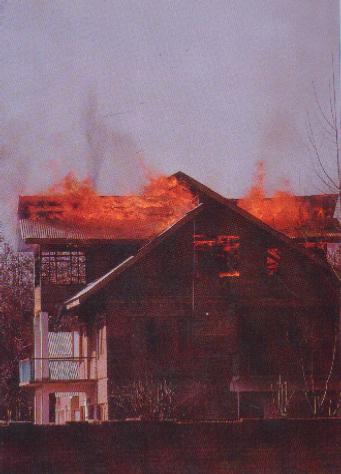|
|
|






|
 |
|
 |
 |
 |
 |
This Happened to Kashmiri
Pandits
A.D.
1389-1413
The
Islamic zeal attained fanatical proportions under Sultan Sikander (A.D
1389-1413) who came to be known as But Shikan (destroyer of idols). "There
was no city, no town, no village, no wood, where the temples of gods remained
unbroken." The Sultan even tried to pull down the famous temple of Martand
but later gave up the effort. Under the influence of the Baihaqi Sayyids,
the Sultan banned un-Islamic practices such as drinking, gambling, dancing,
and playing of musical instruments. The Hindus were subjected to jizia,
and forbidden to apply tilak on their forehead. Sikander also introduced
an institution of Sheikh-ul-Islam to insure that the injunctions of Islam
were fully observed. A relentless campaign for conversion to Islam was
launched, under the charge of the Sultan's Chief Minister, Malik Saif-ud-Din.
The Chief Minister's original name was Suha Bhatta. He renounced his Hindu
faith to accept Islam. The zeal of this neo-convert knew no bounds. He
unleashed a reign of terror against those who resisted conversion. It is
believed that the Sultan and his Chief Minister threw into the Dal Lake
all the sacred books of Hindus that they could lay their hands on, and
seven maunds of sacred threads of murdered Brahmins were burnt. It is from
this period that the predominance of Muslims in the population of the Valley
began.
A.D.
1671-75
During
Aurangzeb's long reign of 49 years, Kashmir saw fourteen governors. They
generally ruled well. But one of them, Iftikar Khan (A.D. 1671-75), persecuted
the Brahmins, and they approached the ninth Sikh Guru, Tegh Bahadur. They
complained to him: "We suffer great atrocities, sacred threads (janeus)
are forcibly taken off our persons. Cows are killed. Janeus, a maund and
a quarter in weight, are snapped in a single day." The Guru consoled them
and said, "Go and tell the Mughal rulers that if they converted Tegh Bahadur
they would all voluntarily accept Islam." This infuriated the Imperial
Court and led to the Guru's martyrdom. And the Sikh faith and history took
a new turn.
A.D.
1762-1811
With
the re-establishment of Afghan rule, the miseries of the people multiplied.
Kashmiris had the misfortune of being ruled by two upstarts - Lal Khan
Khattak and Faquir Ullah. Both were tyrannical to the extreme. The former
was given to fits of insane rage and sometimes got an entire family killed
on mere suspicion. He was particularly hard on Hindus. Faquir Ullah was
equally inhuman. He got hundreds of Kashmiri Pandits killed because he
suspected that his father had been killed at the instance of a Kashmiri Pandit, Kailash
Dhar, who was a nobleman at the time. Another Afghan Governor,
Ata Muhammad Khan, had earned notoriety for his insatiable lust for beautiful
Kashmiri women. The Hindu parents became so apprehensive that they had
the good looks of their girls sullied to evade the attention of the Governor's
agents. Jabbar Khan, the last Afghan Governor, also persecuted the Hindus
relentlessly.
| |
 |
 |
 |
 |
|
|
|
|
|
|
